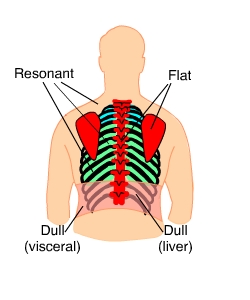Percussion
Percussion is an assessment technique which produces sounds by the examiner tapping on the patient's chest wall. Just as lightly tapping on a container with your hands produces various sounds, so tapping on the chest wall produces sounds based on the amount of air in the lungs. Percussion sets the chest wall and underlying tissues into motion, producing audible sounds and palpable vibrations. Percussion helps to determine whether the underlying tissues are filled with air, fluid, or solid material.
 Percussing the anterior chest is most easily done with the patient lying supine; the patient should sit when percussing the posterior chest. Place the first part of the middle finger of your nondominant hand firmly on the patient's skin. Then, strike the finger placed on the patient's skin with the end of the middle finger of your dominant hand.
Percussing the anterior chest is most easily done with the patient lying supine; the patient should sit when percussing the posterior chest. Place the first part of the middle finger of your nondominant hand firmly on the patient's skin. Then, strike the finger placed on the patient's skin with the end of the middle finger of your dominant hand.
Work from the top part of the chest downward, comparing sounds heard on both the right and left sides of the chest. Visualize the structures underneath as you proceed.
Look at the following diagram that shows percussion notes on the posterior chest:
 |
Resonant
sounds are low pitched, hollow sounds heard over normal lung tissue.
|
| Flat
or extremely dull sounds are normally heard over solid areas such
as bones. |
| Dull
or thudlike sounds are normally heard over dense areas such as
the heart or liver. Dullness replaces resonance when fluid or solid tissue
replaces air-containing lung tissues, such as occurs with pneumonia, pleural
effusions, or tumors. |
| Hyperresonant
sounds that are louder and lower pitched than resonant sounds are
normally heard when percussing the chests of children and very thin adults.
Hyperresonant sounds may also be heard when percussing lungs hyperinflated
with air, such as may occur in patients with COPD, or patients having an
acute asthmatic attack. An area of hyperresonance on one side of the chest
may indicate a pneumothorax. |
| Tympanic
sounds are hollow, high, drumlike sounds. Tympany is normally heard
over the stomach, but is not a normal chest sound. Tympanic sounds heard
over the chest indicate excessive air in the chest, such as may occur with
pneumothorax. |
Instant
Feedback:
The normal sound expected on percussion
throughout most of the lung fields is resonance.
© RnCeus.com
 Percussing the anterior chest is most easily done with the patient lying supine; the patient should sit when percussing the posterior chest. Place the first part of the middle finger of your nondominant hand firmly on the patient's skin. Then, strike the finger placed on the patient's skin with the end of the middle finger of your dominant hand.
Percussing the anterior chest is most easily done with the patient lying supine; the patient should sit when percussing the posterior chest. Place the first part of the middle finger of your nondominant hand firmly on the patient's skin. Then, strike the finger placed on the patient's skin with the end of the middle finger of your dominant hand.